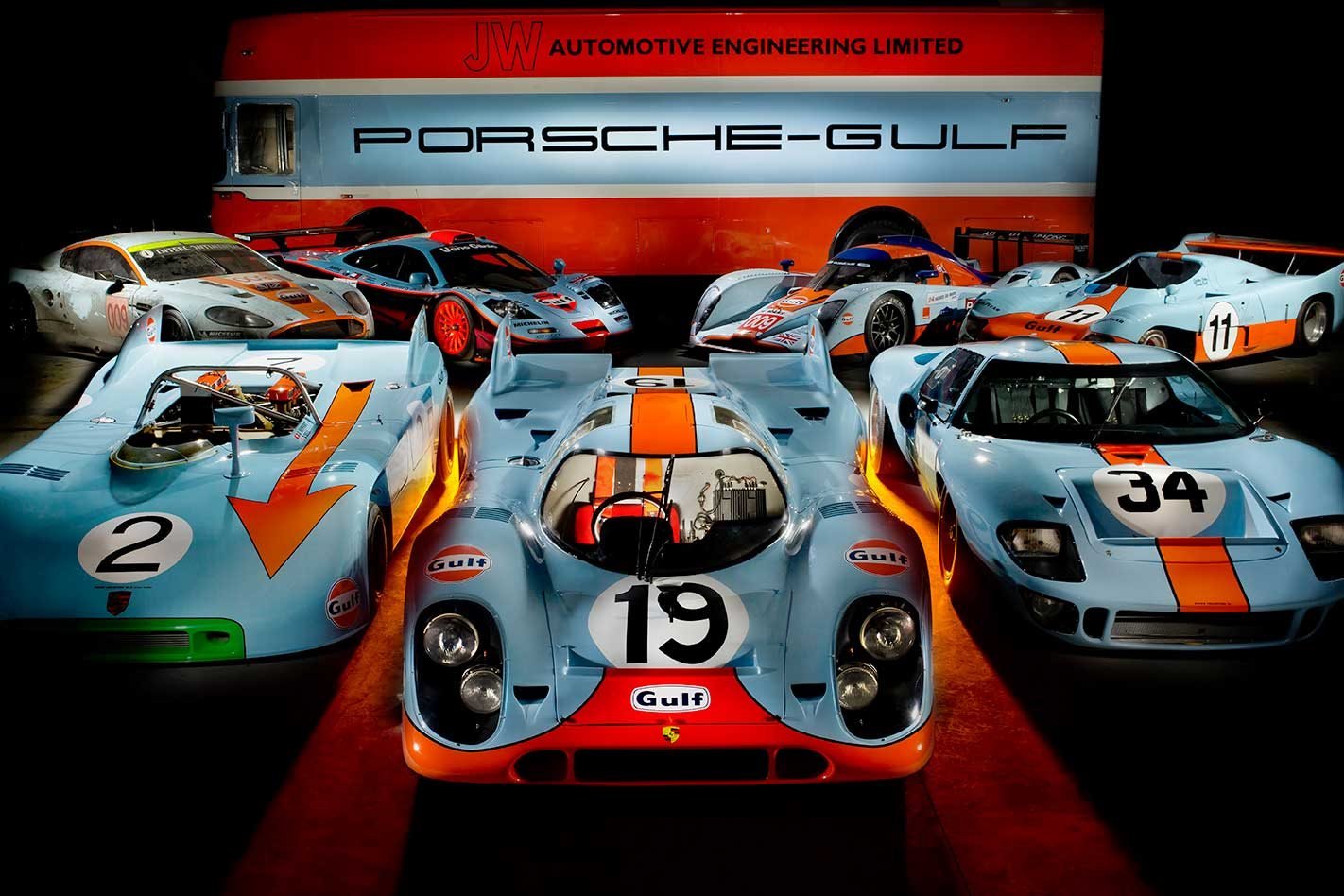As a grid of 50-plus contenders rolled towards the waving tri-colour at the start of last year’s Le Mans 24 hours, two stood out from the high-tech crowd. Yes, Audi’s R18 e-Tron hybrid and R18 Ultra diesel locking out the front row was impressive, and Toyota’s pair of TS030 LMP1s created massive interest.
This feature was originally published in MOTOR’s May 2013 issue
But the duo in question grabbed just as much, if not more attention, simply because of their sponsorship livery and the history it represents.
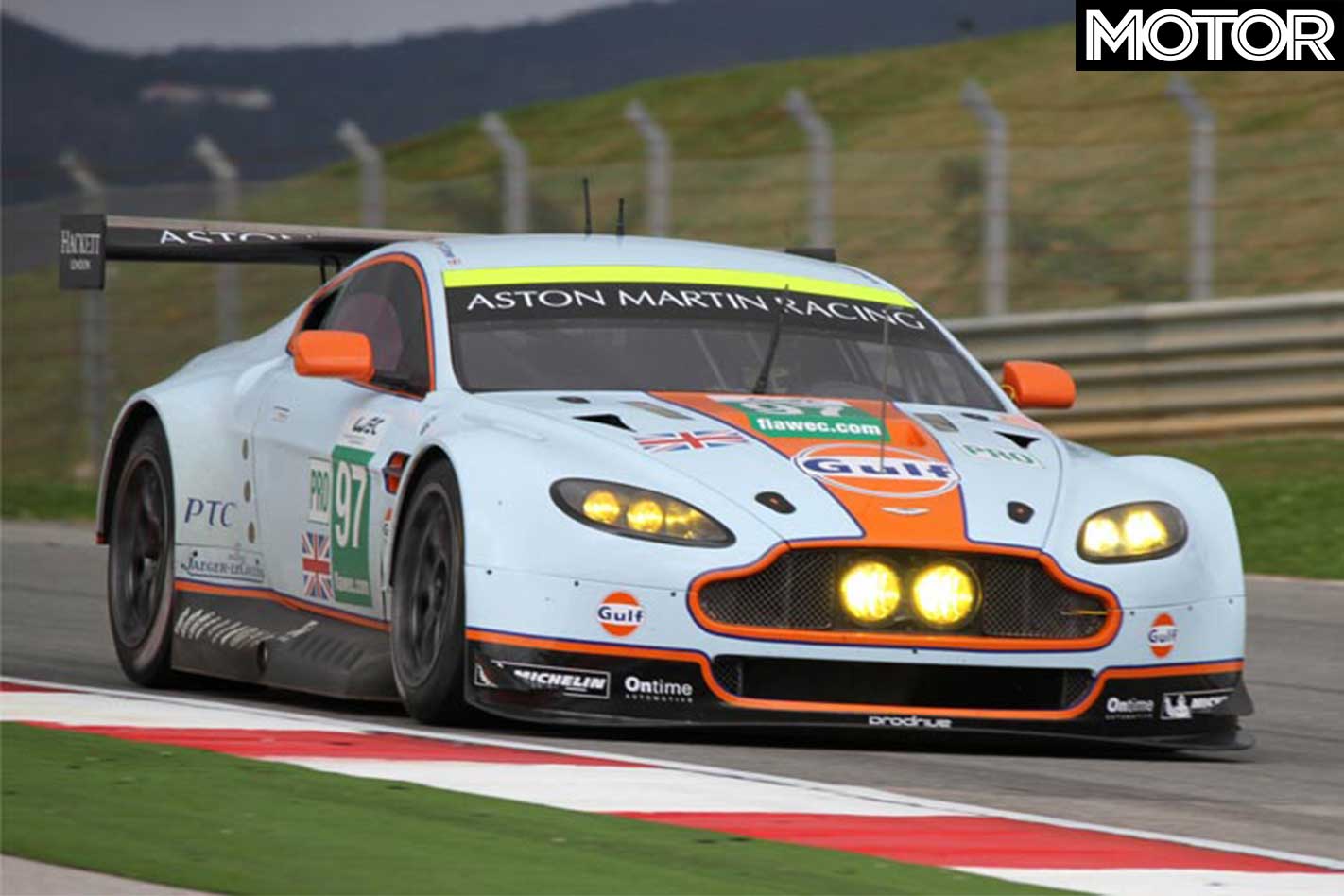
It was more their Powder Blue and Topaz colour scheme, underpinning iconic Gulf Oil logos that generated magnetic attraction for motor sport fans with even a hint of racing heritage in their veins. Put it this way, if the race was decided by on-track merchandise sales, Gulf would walk away with the silverware every time.
Founded in 1901 at Spindletop, Texas, Gulf quickly became one of America’s oil giants, involved in all aspects of the business, from exploration, through refining, to providing the world’s first drive-in service station (in 1911).
From around the 1930s, the company started dabbling in motorsport sponsorship, a marketing strategy that, for many, reached a high point in the 1960s, when British racer and engineer John Wyer led the world sportscar championship winning Ford GT40-based Mirage project.
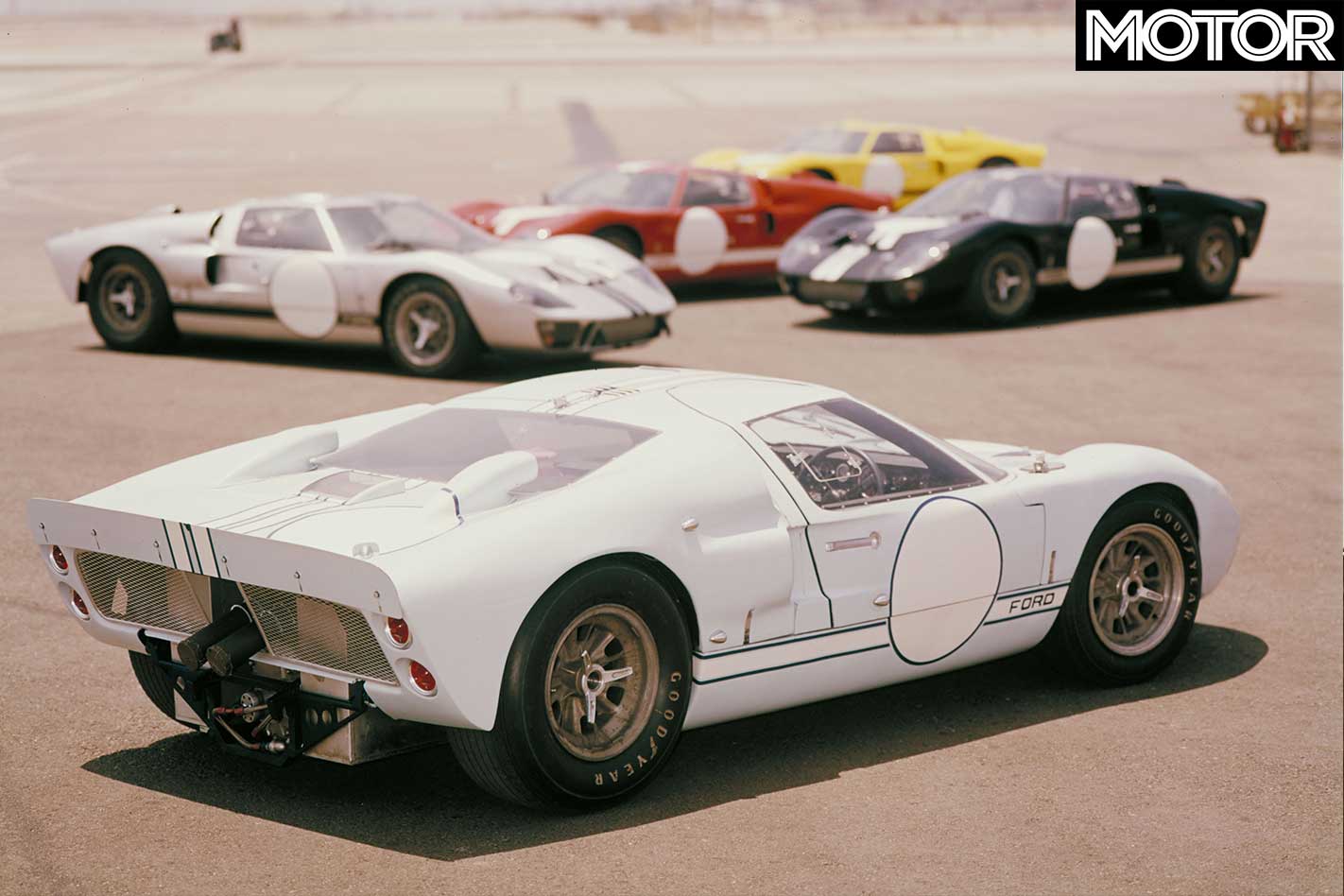
While these giant-killers became bedroom wall pin-ups for a generation of teenage petrol heads, a young German fan became obsessed with the idea of going one up on his mates’ scale models, and one day owning the real thing.
Roald Goethe hung onto that dream over 40 years, and in 2008, the now wealthy businessman tapped Adrian Hamilton, high-end classic car dealer, and son of famous English racing driver Duncan, to help him find one.
The eventual sourcing of an original JW Automotive Gulf GT40 was the catalyst for what has evolved into arguably, the most significant themed, private racing car collection in the world.
The ROFGO (as in ROald F Goethe ) Gulf Collection now contains 25 vehicles; specifically, 24 cars, as well as an original, Mercedes-Benz Gulf Porsche transporter.
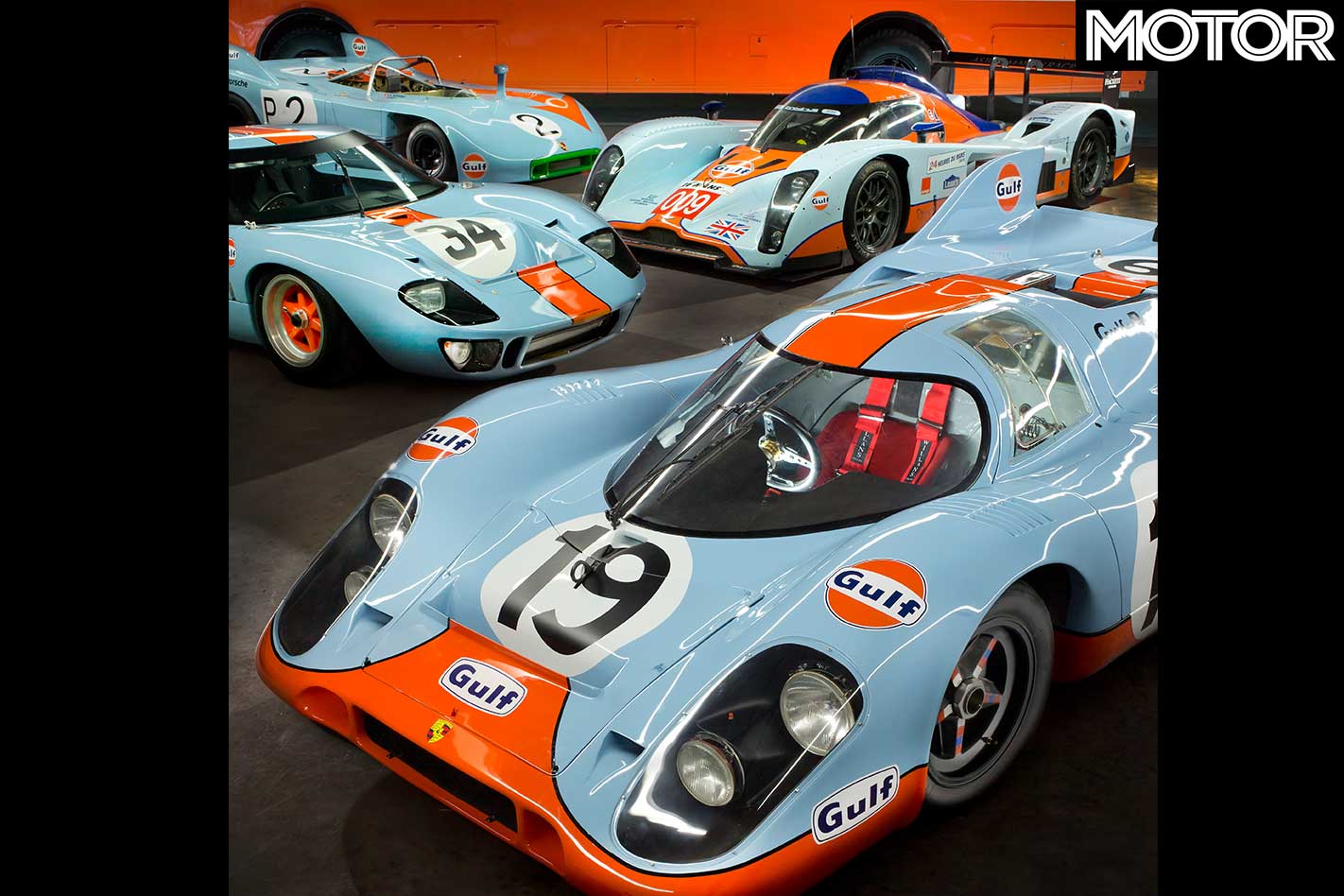
Starting with his original 1965 GT40, the collection stretches up to the current McLaren 12C GT3 Goethe races. It includes F1 and CanAm stars, but the single-minded focus is classic racing cars that wore the blue and orange livery in period.
None are museum queens, with Goethe determined all his cars should be used regularly.
While we could devote an entire issue to the full collection, we’ve drawn the line at eight machines that best embody the Gulf Racing spirit, including the custom built, workshop on wheels that some of them called home.
1967 Mercedes 0317 Transporter
When it comes to rarity, this fully enclosed, Mercedes-Benz-based Renntransporter is up there as one of the most sought after commercials in the classic vehicle world.
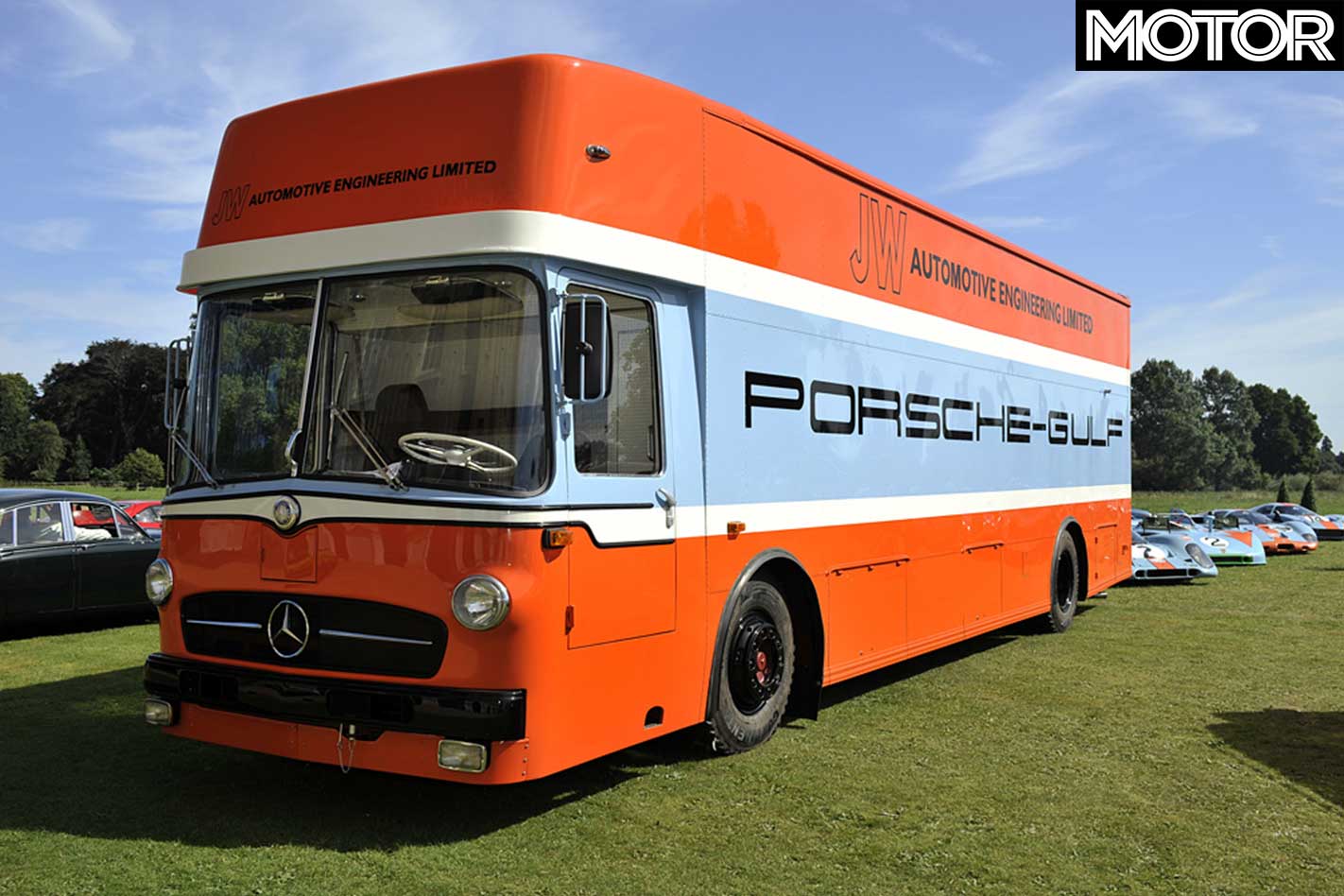
One of three produced by specialist body builder Robert Schenk in Stuttgart, the ROFGO transporter is the actual vehicle that carried the Collection’s Porsche 917 to and from Le Mans in 1971.
Measuring 11m long, 4m high, and sitting on a Mercedes-Benz 0317 bus chassis, the custom body provides load space for four (Porsche) racing cars and bunks for two crew.
Adrian Hamilton found this example in Florida, in Rothmans colours. Another of the trio resides in the USA, and the third is believed lost. According to Hamilton, it was in terrible nick. “It looked as if had spent the last 30 years on the floor of the ocean.”
Restoration was entrusted to Yorkshire-based specialist, WHF Ltd, supplier of support trailers and hospitality units for motorsport, including the Red Bull, McLaren, Williams and Mercedes-Benz F1 teams.
A full mechanical and ground-up body restoration took over a year to complete, and the now immaculate transporter is ready for hauling its precious cargo.
Powered by a 10.8-litre straight six diesel, producing a mighty 157kW, the transporter is in Class One condition, and the striking Gulf livery and period-correct JW Automotive branding is superb.
The cabin is spot-on, with even the driver’s seat suspension system given a complete overhaul. From the (near horizontal) steering wheel, to the vinyl door cards, chrome-trimmed sun visors and perforated panelling behind the bunks, this truck is as it would have been when it rolled out of the Schenk works 46 years ago.
Even a detail like sourcing the correct fuel gauge was a no-expense-spared exercise, with a replacement item ultimately found in Russia.
“It cost £300,000 just to restore, and a whole lot more to buy,” says Hamilton, “but the collection would not be complete without it.”
The transporter is a working team vehicle, already scheduled to carry the Porsche 908/3 and 917 to next July’s Le Mans Classic. What a paddock sensation that arrival and unloading will create.
2009 Lola-Aston Martin LMP1
In an era of late noughties diesel domination, Aston Martin’s then relatively new owners continued to dive in the deep end of world sports prototype racing, and the Lola-based B09/60 LMP1 was its weapon of choice for the 2009 season.
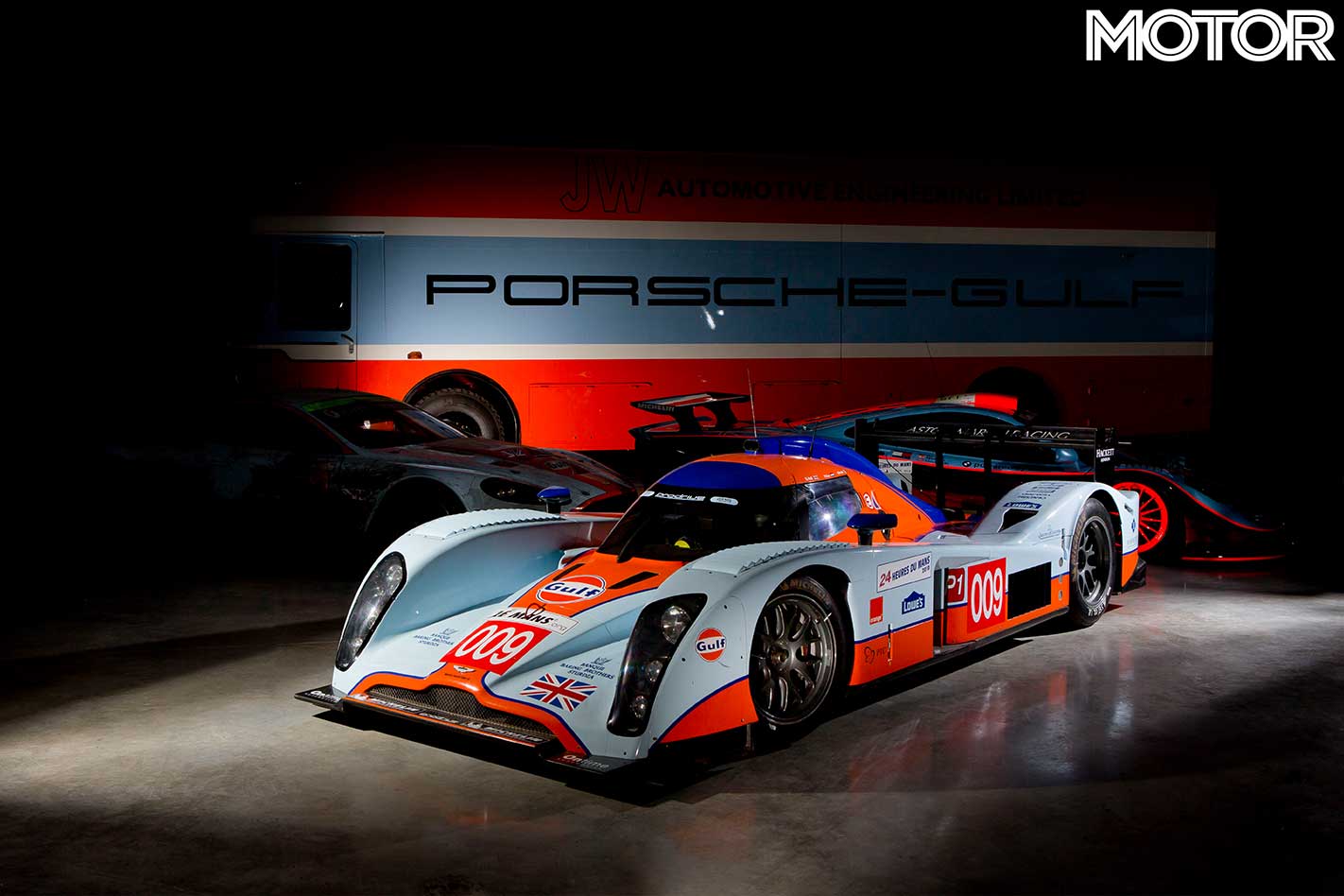
Powered by a race tuned, 485kW/770Nm version of the all-alloy, 6.0-litre, petrol V12 found in the Vantage road car, it’s an evolution of the previous year’s B08 chassis, with revisions to the bodywork, suspension, and a more compact Xtrac sequential six-speed ‘box, with wheel paddle operation.
As well, the B09 features rear facing brake cooling ducts, incorporating fans, cancelling out the need for intakes on the rear deck, and improving aero performance. Three chassis were built by Lola, with Prodrive managing the program, and Aston Martin developing the engines.
Despite a strong showing in Le Mans Series racing, the Aston was always going to struggle against the might of Audi and Peugeot at Le Sarthe. A modest air-restrictor concession for running a production-based engine helped, but the technical regulations were still stacked firmly in favour of diesel power.

In the end, the team did well to come in fourth behind a Peugeot 908 one-two, and Audi’s R15 in third; Aston’s best result at the famous race in 50 years.
The ROFGO Collection car, in the hands of Anthony Davidson, Darren Turner and Jos Verstappen, ran as high as third outright, but an on-track altercation dropped it to 13that the finish. Two months later, it went on to record its best result of second at the Nurburgring 1000km (behind the winning sister car).
Sadly, an arm-wrestle over naming rights became public, with Lola demanding its fundamental role in the car’s development be recognised, while Aston wanted to call it the DBR1-2 in recognition of the 1959 Le Mans winner (as driven by Carroll Shelby and Roy Salvadori).
The factory even went as far as attaching DBR1-2 ID plates to the cars, but Lola eventually won the day, pointing out it is ultimately, an Aston powered Lola.
1997 McLaren F1 GTR Long tail
This is the car McLaren chief Ron Dennis and principal designer Gordon Murray said would never go racing. Built to be the ultimate road car, the McLaren F1’s ultra-light carbon construction, staggering dynamics, and mid-mounted, 6.1-litre, 467kW, naturally aspirated BMW M V12 re-set the ‘supercar’ bar. At launch in 1992 it instantly rendered the existing crop of exotic, hyper-sports cars second rate.
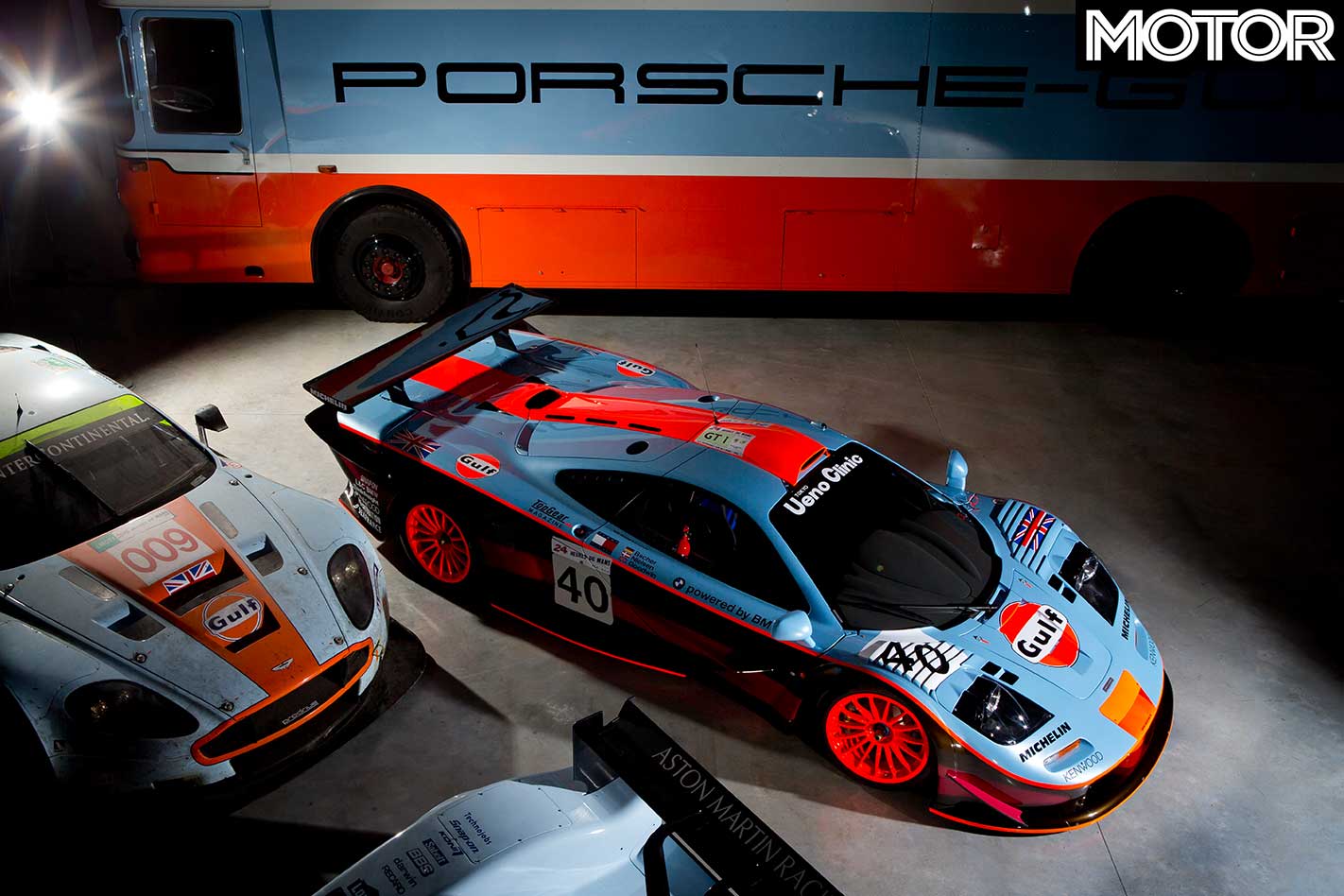
Sure enough, by the mid-‘90s McLaren’s competitive instinct had taken over, Dennis and Murray had eaten their words, and the car became a force in international GT racing. So much so, that in 1995 McLaren became the first marque since Ferrari in 1949 to take outright victory at Le Mans on debut, the F1 GTR proving it was no fluke by cleaning up in both years of the Global GT Series; courtesy of Thomas Bscher and John Nielsen in ’95, then Ray Bellm and James Weaver in ’96.
With Mercedes-Benz whispering about a comeback to top-tier sports car racing, the FIA was keen to accommodate the German giant, and the new for 1997 GT Championship was the result. Porsche had already introduced its 911 GT1 during the ’96 season; essentially a purpose-built racer with a handful of road cars built to satisfy homologation criteria, and Mercedes was set to follow suit in 1997 with the CLK-GTR.
The F1’s long travel, road-derived suspension and relatively high, ‘1+2’ cockpit suddenly put it at a huge mechanical and aero disadvantage. Revised engine regs for the new championship also meant the F1’s monster V12 was de-stroked to 6.0-litres, the consequent power loss partly offset by weight-saving additions like a compact, sequential gearbox.
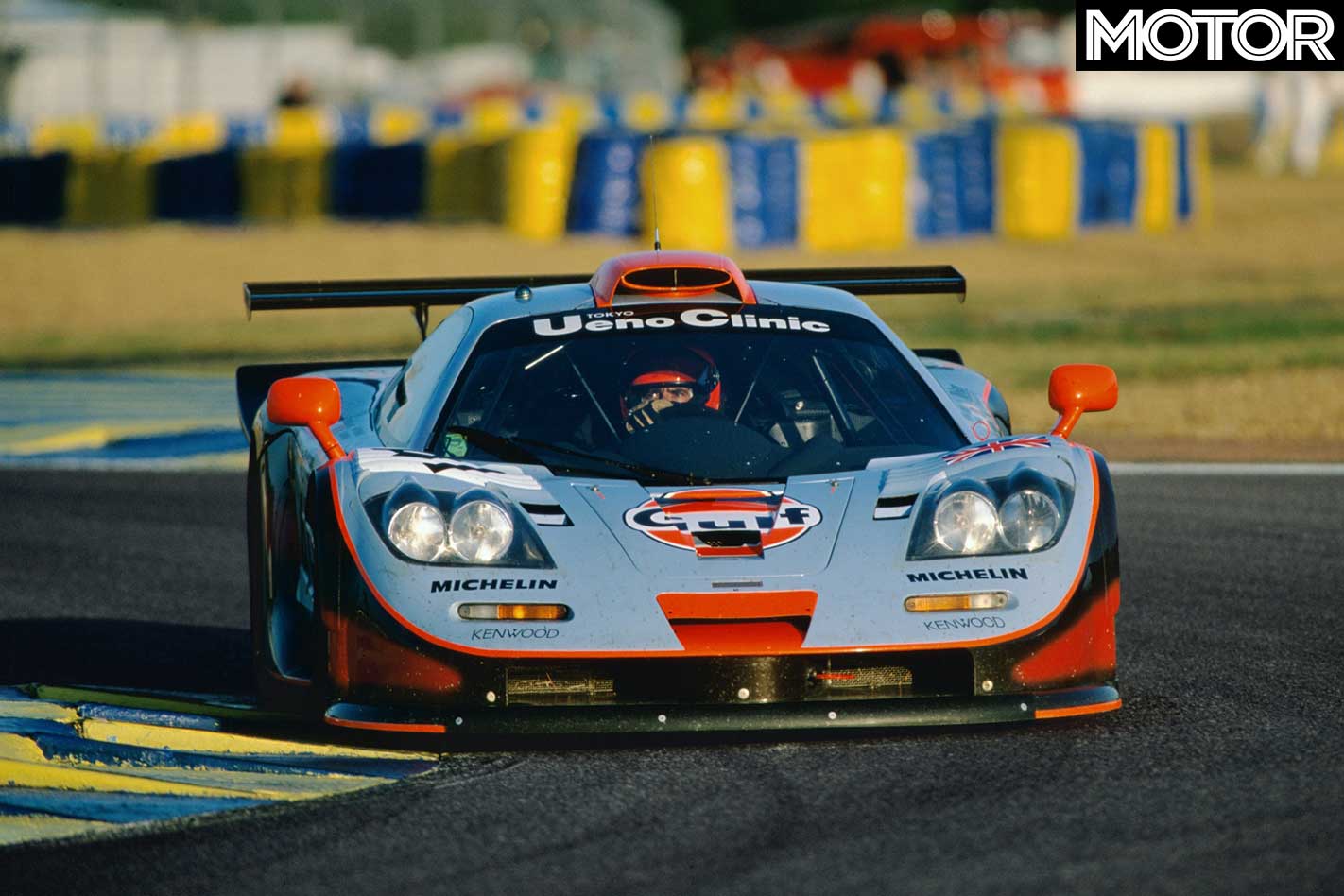
To claw back ground on the new competition Murray developed a ‘longtail’ version of the F1 GTR, with front and rear body work extended dramatically to deliver much-needed extra downforce. A determined weight loss campaign also trimmed overall mass to just 910kg.
After early season success for the F1, the radical CLK-GTR started to find its feet, and won the 1997 title, with McLaren team-mates Steve Soper and JJ Lehto tied for second.
The ROFGO Collection’s Gulf car was run by the ’95 BPR champs, Bscher and Neilsen, coming third at Hockenheim and Helsinki, and in ‘98 Bscher (sharing with Geoff Lees) used it to win the Monza 1000km.
1971 Porsche 908/3
In these conformist and politically correct times it’s hard to conceive of pure sports racers thundering around public roads for close to 800km, at speeds approaching 300km/h, watched by hundreds of thousands of race mad fans. Targa Tasmania is brilliant, but the ‘real’ thing, the Targa Florio that inspired it, was on another level.
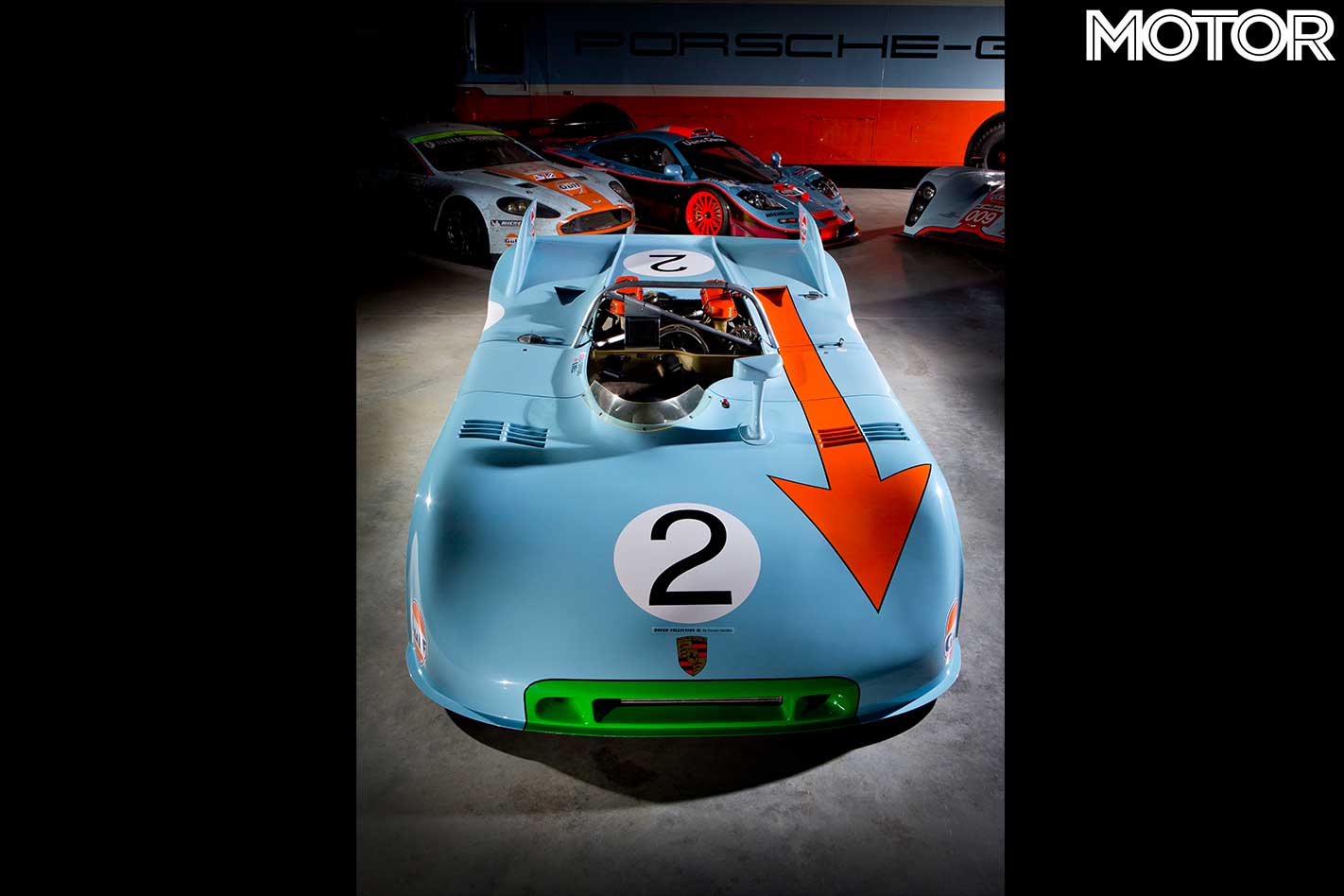
For over 70 years, until the final running in 1977, this amazing road race, around the Italian island of Sicily, captured the motor racing world’s imagination, and among the Bugattis, Alfas, Maseratis, and Ferraris that claimed victory over the decades, this Gulf Porsche 908 stands tall.
Specifically developed for tight, twisting events like the Targa, and Nurburgring 1000km, its 3.0-litre, air-cooled, 180 degree ‘flat’ eight cylinder engine, mid-longitudinally mounted in the alloy space-frame chassis, produces 269kW/365Nm.
The 908/3 made its race debut at this event, and in the hands of Swiss ace Jo Siffert and works driver Brian Redman, the lead Gulf entry took outright honours to register Porsche’s 10th Targa victory. The following year, German Kurt Ahrens and versatile Brit Vic Elford in the rival Salzburg team car took out the Nurburgring 1000km.
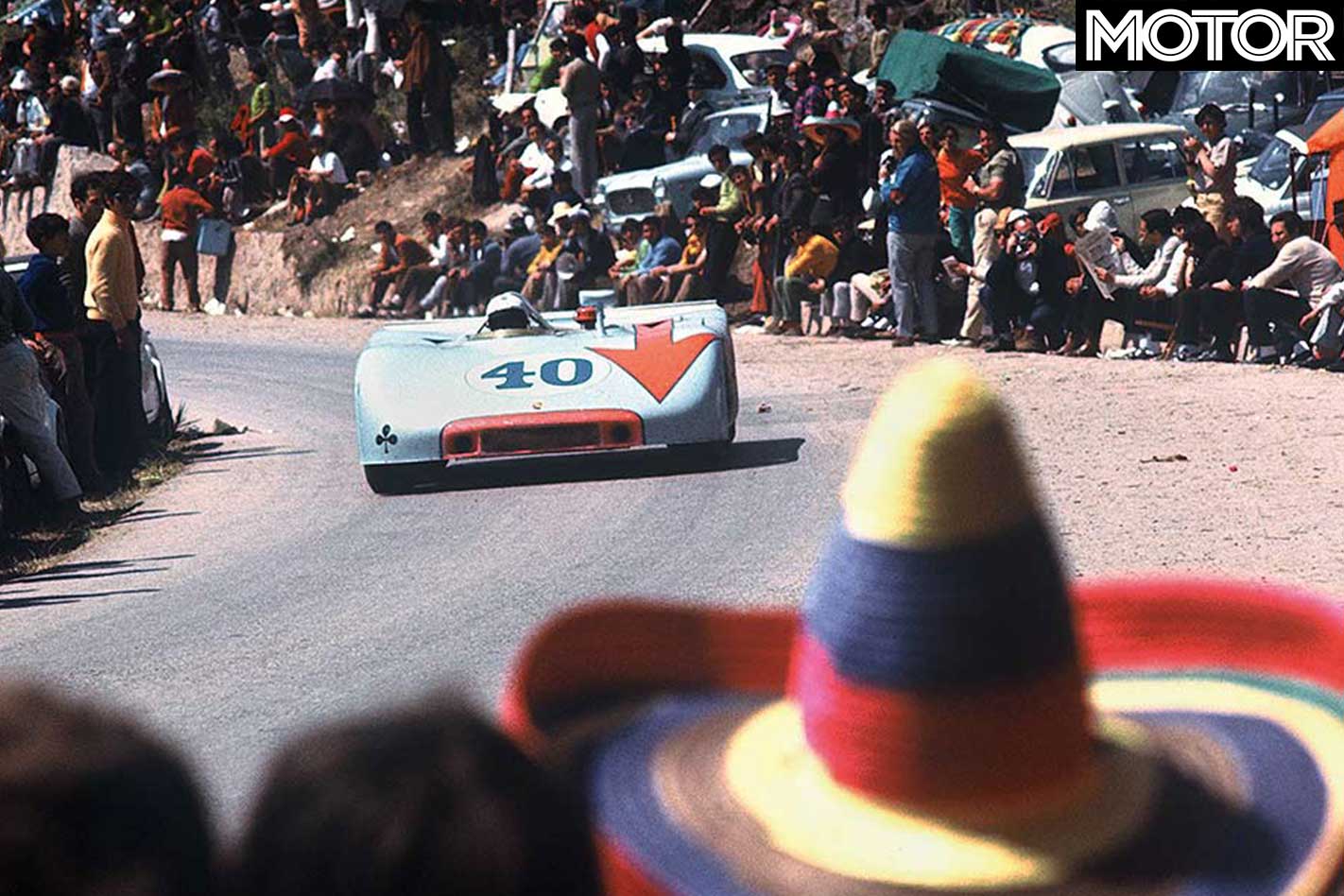
Although it carries the 908 designation, this third generation variant is essentially underpinned by the same chassis as the 1968 909 Spyder, that enjoyed huge success in hill climbs in the late 1960s. The close to central driving position, places the driver’s legs over the front axle, the wheelbase is just 2.3m long, and kerb weight a tiny 545kg .
To this day it’s Redman’s favourite. “A jewel of a car,” he says, “You look at that non existent wheelbase and think it must be twitchy as hell but nothing could be further from the truth. It was fast, friendly, and with that torquey flat eight motor, wide tyres and no downforce, it was an absolute dream to drive on the Targa.”
The collection example, chassis 12, competed once in Gulf colours, with Siffert and Derek Bell qualifying fifth for the ’71 Nurburgring 1000km, eventually retiring from second place with a broken frame. Bought by Reinhold Joest’s factory-supported team in 1974, it continued in competition until 1978.
1965 Ford GT40
Revenge may be a dish best served cold, but Henry Ford II’s outrage following Enzo Ferrari’s ‘nearly-for-sale’ flirtation with the blue oval in the early 1960s generated enough heat to win the Le Mans 24 Hours … several times.
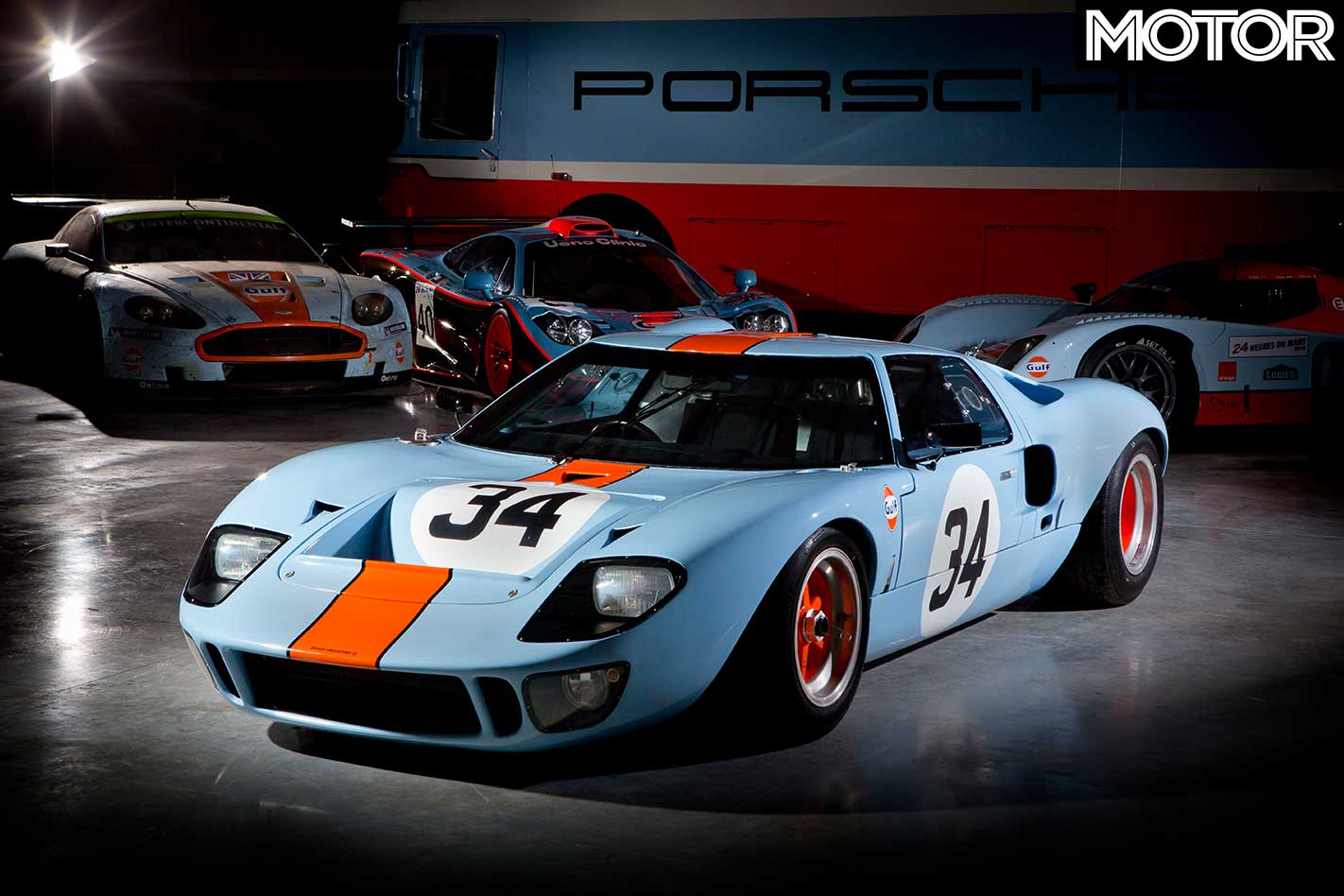
After initial overtures from the cagey Italian, Ford spent big bucks on pre-purchase due diligence, only to have Ferrari turn on his heels over issues relating to the scuderia’s racing program. In the aftermath, Henry II decided to hit Enzo where it hurt most, funding a motor racing program specifically designed to knock off Ferrari at Le Mans.
Ford fast-tracked development through collaboration with Lola Cars, and after a shaky couple of years, where the GT40 proved fast but unreliable, the decision was made to replace the Mark I’s 4.7-litre (289ci) V8 with a 7.0-litre (427ci) big-block monster.
The classic Detroit, ‘more is better’ solution worked brilliantly, and the GT40 MKII dominated Le Mans in 1966 with a 1-2-3 result. Just to make sure Maranello received the message loud and clear, the GT40 followed that up with victory in 1967, ’68 and ’69.
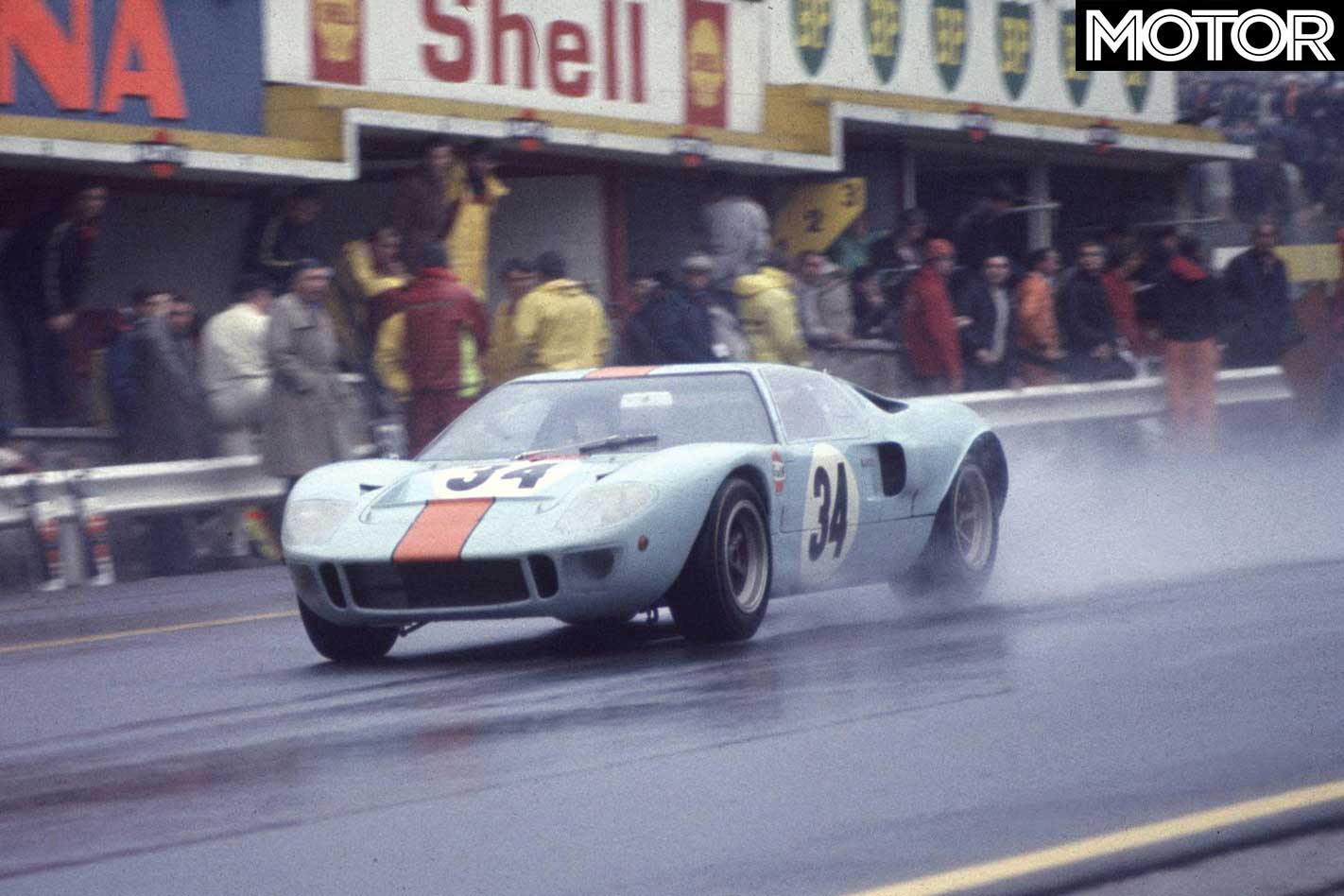
The ROFGO Collection GT40 was originally a private Rob Walker team entry, driven by Bob Bondurant and Umberto Maglioli in the 1965 24 Hour race. Head gasket failure sent it to the DNF column at the two-hour mark, and after the race it was unceremoniously returned to Ford Advanced Vehicles, stripped down and moved to a dark corner, where it sat for the next two years.
But fresh regulations for the 1968 season gave what would otherwise be an out-dated cast-off a new lease of life. Competing cars with an engine capacity of more than 3.0-litres needed to be supported by a run of 25 vehicles, which played perfectly into Ford’s hands.
The ex-Walker car was refettled, finished in Gulf colours, and given a new chassis number (P/1084). While its sister car, P/1075 took all the glory by winning Le Mans in 1968 (and in the ultra-close finish of ’69), P/1084 picked up fourth at the 1000 Kilometres of Spa, driven by David Hobbs and Aussie Paul Hawkins.
2006 Aston Martin DBR9
The ROFGO Gulf Collection wouldn’t be complete without Le Mans winners, and this is one of them. Still wearing the grime accumulated over 24 hours and 344 laps of racing in the 2008 event, this is the car Darren Turner, Antonio Garcia, and our own David Brabham drove to victory in the GT1 class that year.
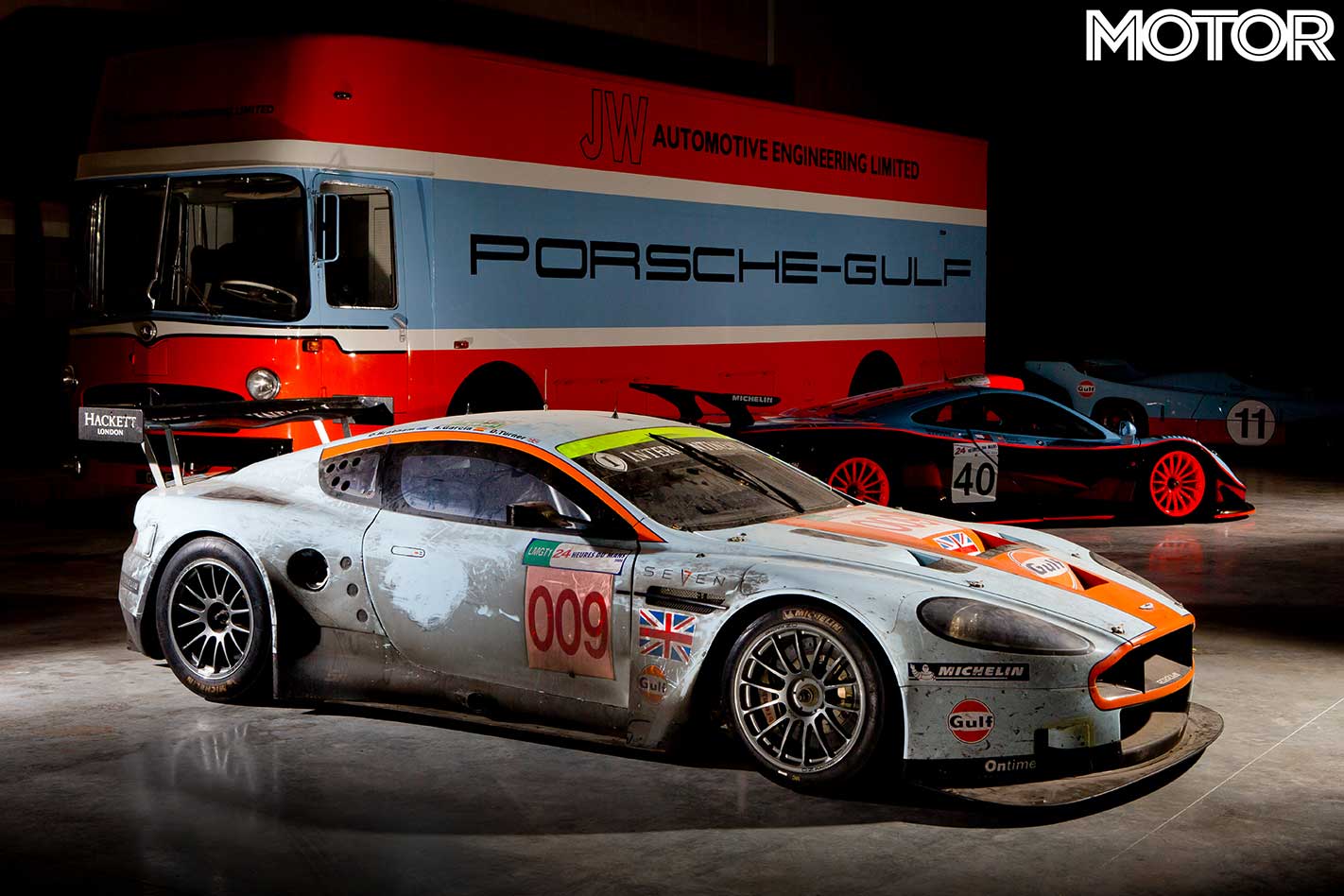
It had started life in 2006 contesting the American Le Mans Series, and finishing sixth outright at Le Sarthe. Enough, you’d think, to easily secure GT honours, but a lone Corvette, finishing an unbelievable fourth, put paid to that. Campaigned by BMS Scuderia Italia in the 2007 FIA GT Championship, it returned to the factory team at the end of that season.
But Aston’s DBR9 project had begun in 2005. Built around the DB9 road car, it took the output of its 6.0-litre V12 up from 350kW/600Nm to around 450kW/700Nm; the development standing the team in good stead for its step up to LMP1 with the Lola B08/60 in 2008.
At Le Mans in 2005, the factory team finished third in class behind a pair of Corvettes. The next year its best position was the collection car’s sixth, with that pesky Corvette grabbing the GT crown. But it was third time lucky when Turner, Brabham and Rikard Rydell climbed to the top step of the podium in 2007, finishing fifth outright and putting a full lap on the nearest Corvette in sixth.
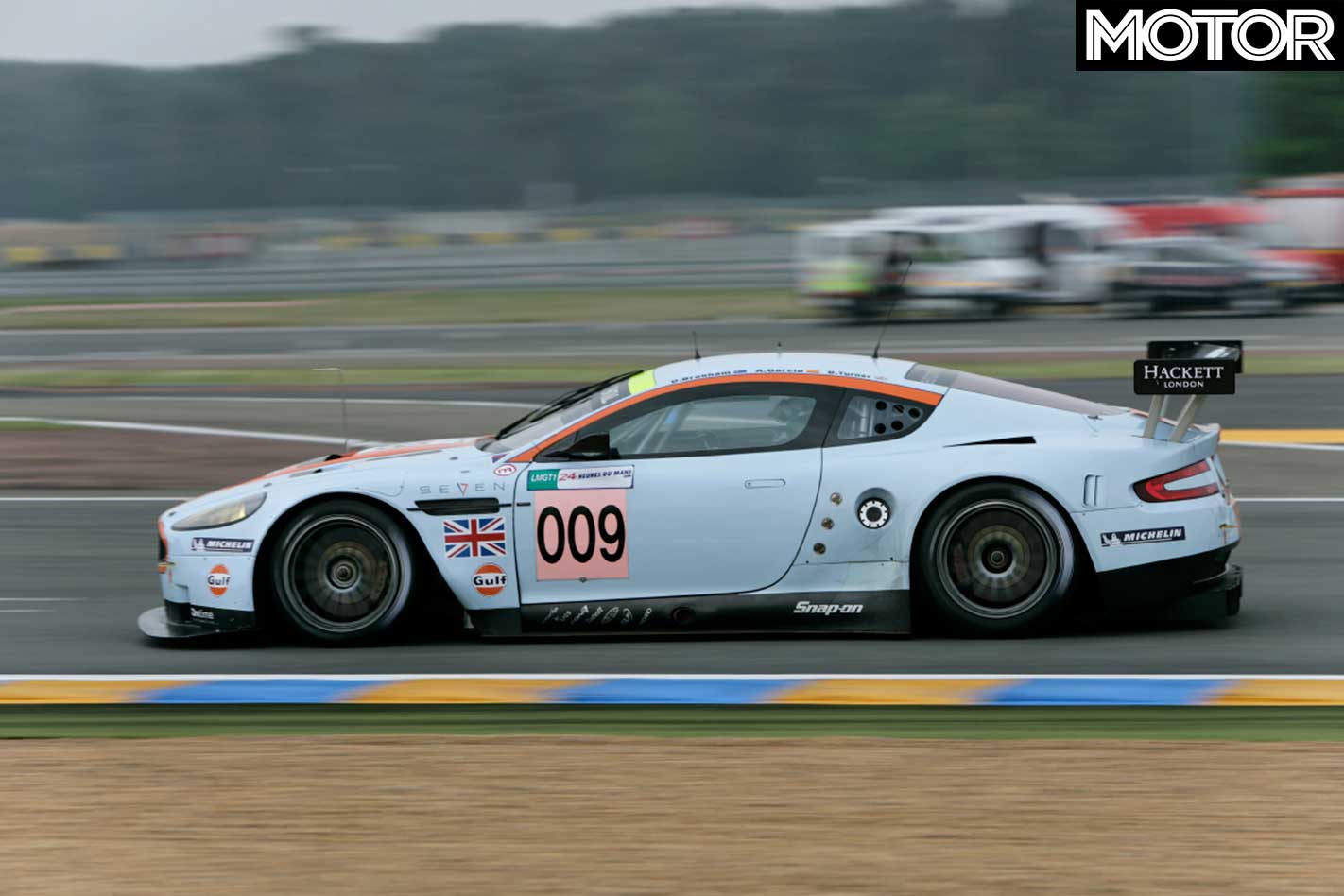
In the close to 50 years since Carroll Shelby and Roy Salvadori famously won Le Mans in the DBR1 (with the team managed by John Wyer), Aston Martin had been chasing sports car competition success. Project 212, 214 and 215 in the early 1960s, was followed by the Aston-powered Group C Nimrod in 1982, and the AMR1 in 1989.
All were nobbled by shaky company finances, and it wasn’t until cash from new owner Ford began to flow in 2004 that the racing program stabilised, and Aston martin enjoyed the taste of Le Mans victory with the DBR9.
1975 Mirage GR8
The thundering Porsche 917s and Ferrari 512s of the early ’70s, made even more famous courtesy of the Steve McQueen Le Mans feature in 1971, were consigned to history by the FIA’s revised ‘Group 5’ regulations for the 1972 sports car season.
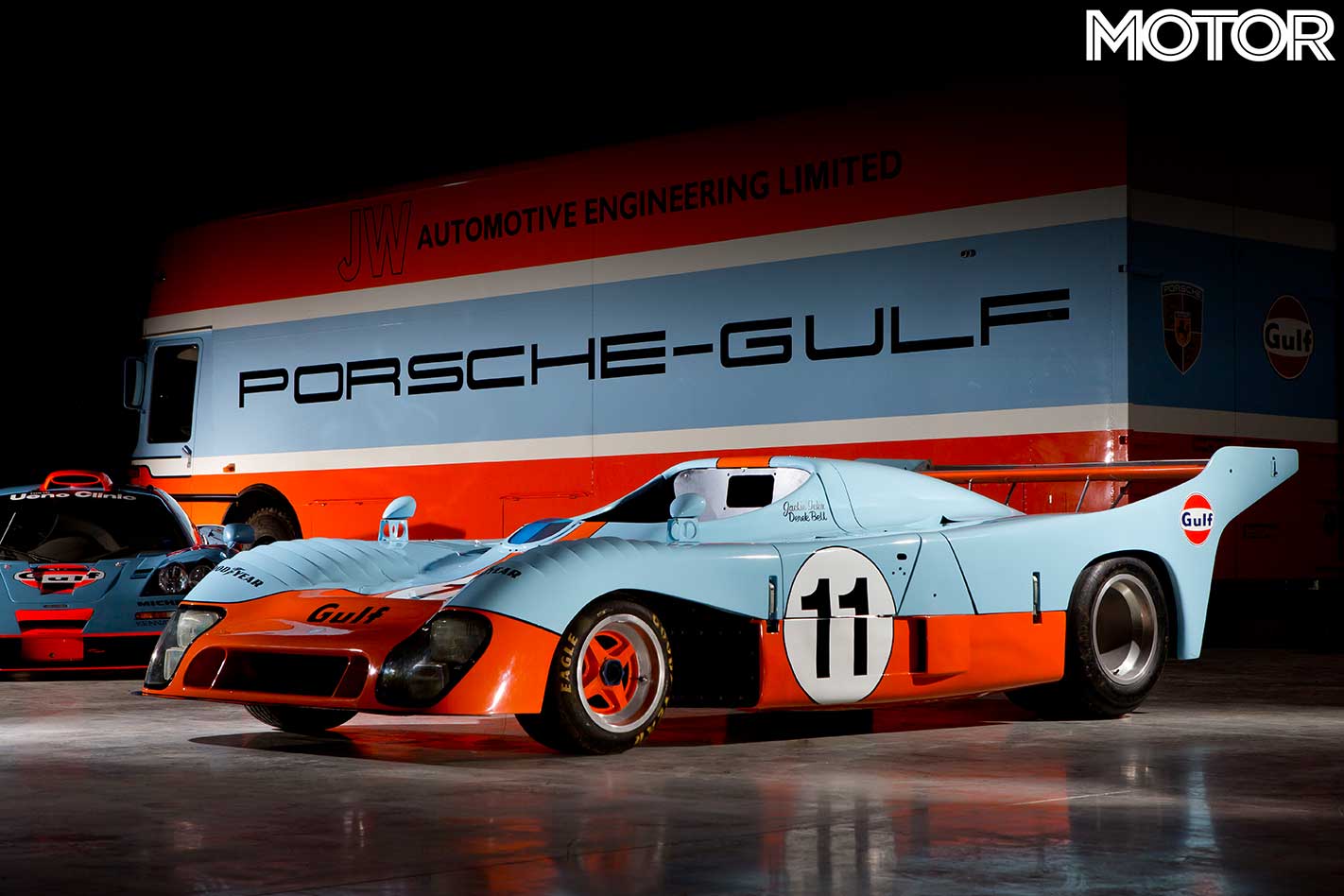
The ‘oil crisis’ was biting hard, and maximum engine capacity for the premier category was set at 3.0-litres. As well the Automobile Club de l’Ouest (ACO) mandated a minimum 20 lap re-fuelling gap, and specific fuel tank capacities for Le Mans.
John Wyer had created the Mirage brand in 1967 to differentiate his team’s Gulf Ford GT40-based M1, as well as many others to follow, and it was attached to his team’s 1975, Group 5 compliant, Le Mans challenger.
After close to a decade, the JW Automotive team’s association with Gulf Oil was about to end, and Wyer was determined to give it a successful send-off, and the Mirage GR8, this exact car in fact, was ready to provide it.
Two GR8s lined up for Le Mans in 1975, each powered by a mid-mounted, 3.0-litre Ford-Cosworth DFV V8, detuned for long-distance reliability, and improved economy.
The emerging dream team of Jacky Ickx and Derek Bell was paired in one car, with local Jean-Pierre Jaussaud and our own Vern Schuppan in the other. Ickx and Bell qualified first, with Schuppan and Jassaud joining them for a front row lock-out.
After leading early on, electrical problems caused Schuppan and Jassaud to drop back during the night, but Bell and Ickx took over, eventually building a long enough lead to allow the team to change a cracked exhaust manifold on the Sunday afternoon, and despite bangs and graunches from what proved to be damaged rear suspension, won the race by a lap from the second place Ligier JS2. The second Mirage came home third.
At the end of the ’75 season, Wyer sold the team, including the Mirage name, but this very car had delivered the perfect retirement present. And the other Gulf GR8? It’s in the ROFGO collection, too.
1971 Porsche 917K
Ask a hard-core Le Mans fanatic to name the event’s most iconic competitor, and this is the car they’ll nominate.
The Porsche 917 walked away with Le Mans victory in 1970 and ’71 (the latter with current Red Bull advisor, Helmut Marko sharing the drive). But no matter what the McQueen film would have you believe, no Gulf 917 ever won the race.
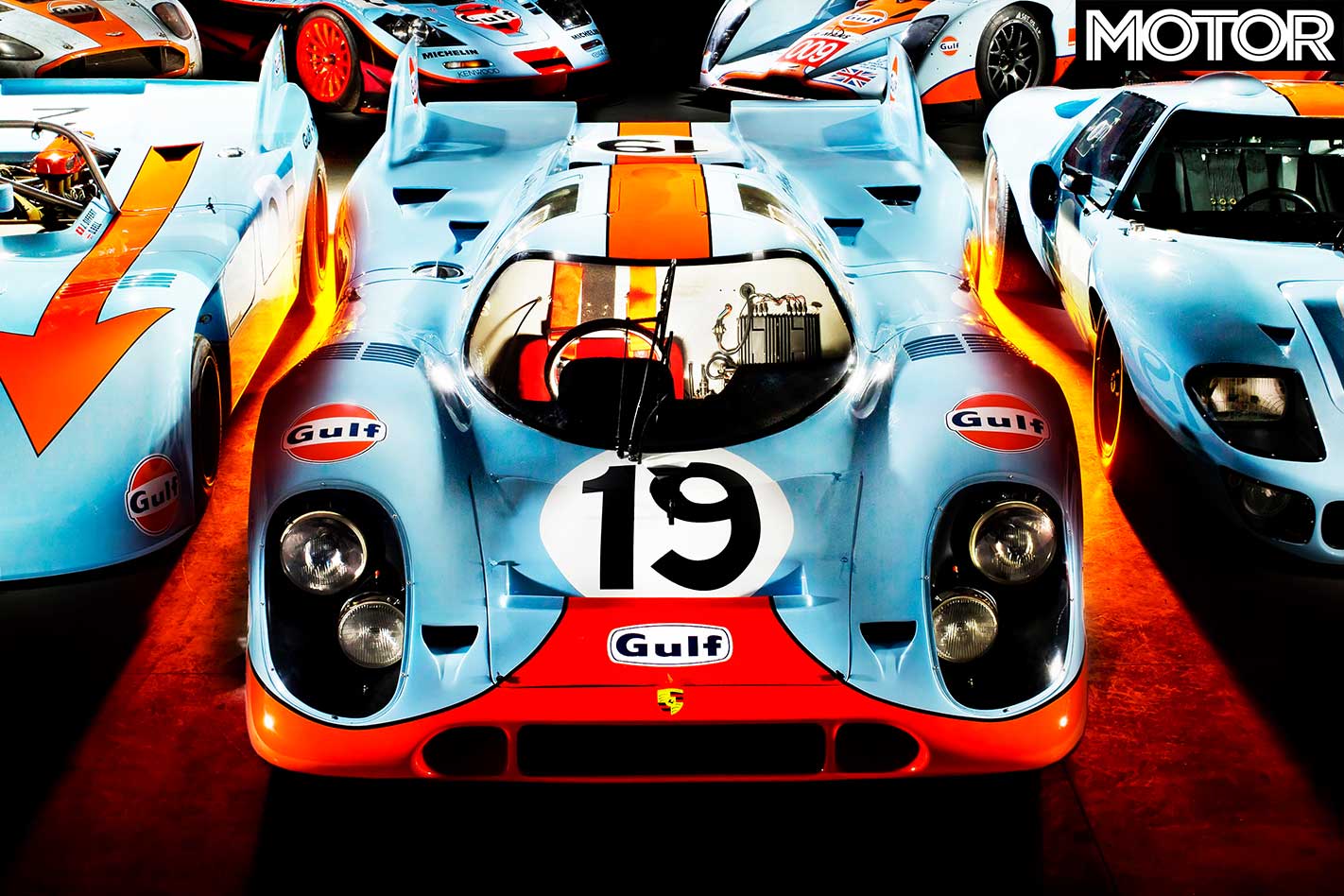
Despite that, this 1971 Gulf racer is without doubt the most spectacular and charismatic car in the ROFGO collection.
Then head of Porsche’s motorsport, and now VW Group chairman, Ferdinand Piëch, led development of the car, that included a lightweight alloy frame, and 450kW, 4.5-litre, air-cooled, naturally aspirated, ‘flat’ 12 cylinder engine. In later turbo iterations, the 917 would produce more than 800kW.
The collection example, 917/26, started life as a test car in 1969, but came off the bench and stepped up to the premier league the following year, competing at Le Mans in the hands of David Hobbs and Mike Hailwood.
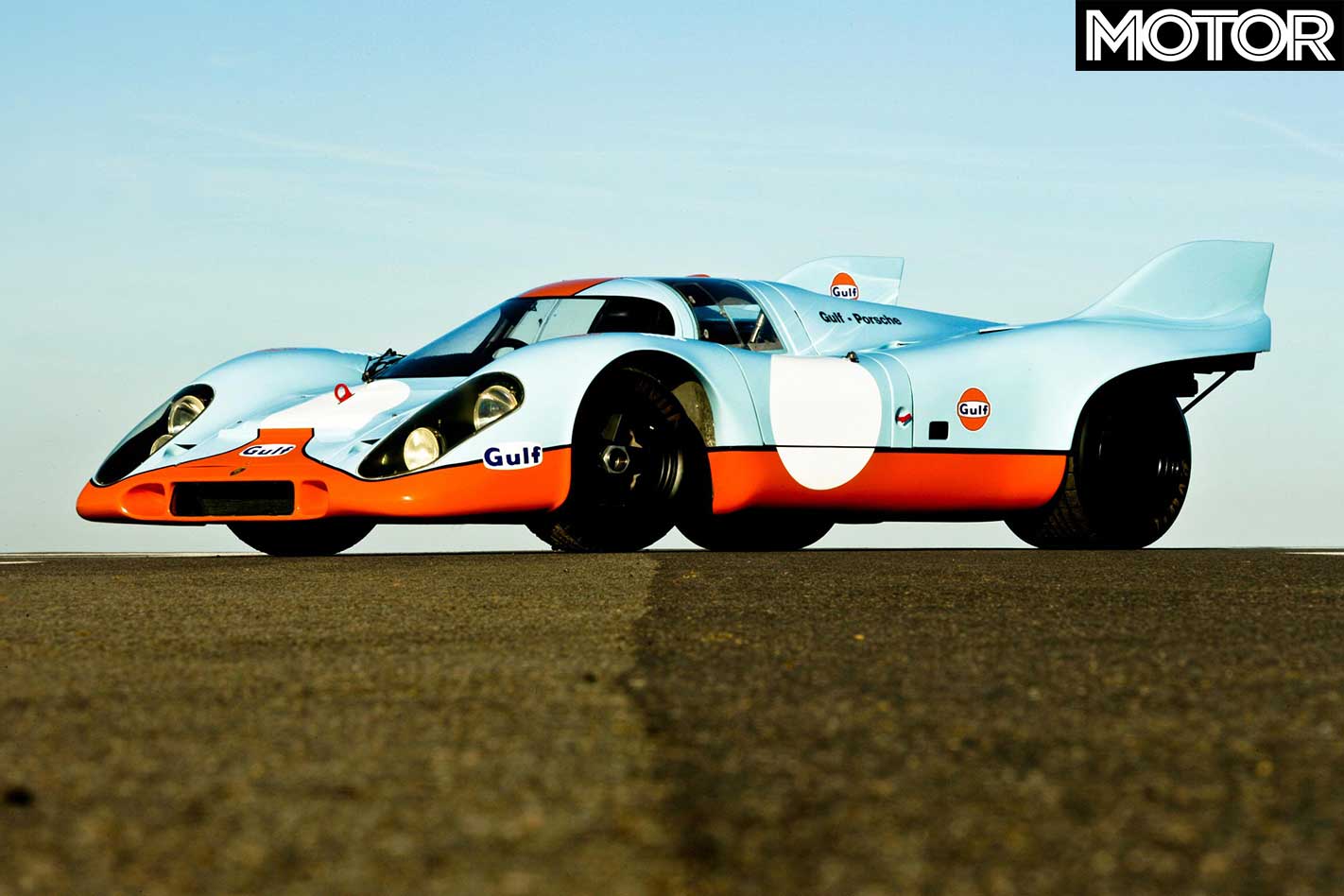
Multi GP bike world champion Hailwood must have thought he was still on two wheels rather than four, crashing the car so badly it required a new frame. Wearing a new chassis number (917/31), Brian Redman steered it to victory at Imola and the last championship race of the season at Zeltweg (sharing with Jo Siffert).
In 1971, Siffert and Derek Bell brought the car home in fifth place at Sebring, before 1970 Le Mans winner, Richard Attwood and dual Targa Florio winner, Herbie Muller delivered the best ever result for a Gulf 917 at Le Mans, finishing second, two laps adrift of the Martini 917 of Gijs van Lennep and Marko, which averaged 222km/h over 24 hours, the highest speed recorded to that point in the race’s history.
After a several relatively undistinguished seasons in Interserie and other similar events, the car was retired from active duty. But it’s now restored to full, Le Mans spec glory, complete with short-tail, finned bodywork, 5.0-litre engine, five-speed ‘box and that classic Gulf livery. A pristine example of one of the greatest racing cars ever made.

